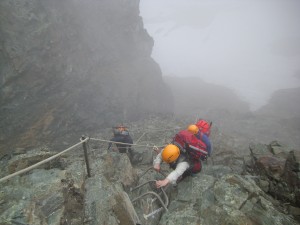Ascent to the highest mountain in Austria
On Friday, the 1st July 2011, I boarded the plane to Munich and from there I traveled by train to Zell am See in Austria. The destination of my trip was the Glocknerhaus at the foot of Großglockner, Austria’s highest mountain (3798 m). I had signed up to a high-tour training with the DAV Summit Club to gain initial experience in mountain climbing. There are many different offers from the Summit Club like introductory and basic courses on rock, ice or a combination of both. This high-tour training with several 3000m peaks and the climbing of Großglockner to top it, I found most exciting.
When I arrived after a scenic train ride in Zell am See on Saturday evening, I met with one of the other three participants for dinner. Philipp from Cologne had also recently started with mountain climbing, but he is an enthusiast whose passion for mountain climbing on this tour should increase even more. Sunday morning we went by bus to the Glocknerhaus. In the bus we met Friederike, the number 3 in our tour group. Frederike had just as Philipp experience in climbing, but not so much in mountaineering or high-tours.
The Glocknerhaus at 2139 meters was our home for the next week, and we could not complain about it really. The location was a great starting point for the upcoming tours, and after the tours, there was always a cold “Radler” (beer with Almdudler) waiting to us as well as my daily “Flädlesuppe”, a meat soup with pancake stripes. In the evening we got a delicious three-course meal. In the afternoon we had time for a little hike to the Stockerscharte at 2422 m – a good idea for high altitude acclimatization we supposed. We were rewarded with a beautiful view of the valley and the sighting of an eagle majestically circling above us. In the evening we had the first introduction where we met Frank, our fourth man – a cheerful Westphalian, with whom I shared a room – and of course Helmut, our mountain guide. We were lucky that our group consisted of only four participants (normally there are up to eight) and that we got along so well. The combination of Austrian, Rhenish and Westphalian humor was a guarantee for many good laughs over the next week.
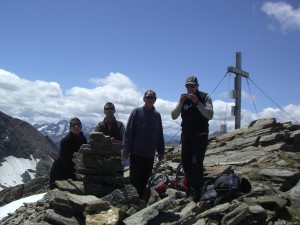
Friederike, Philipp, Frank and Helmut at the top of Hoher Spielmann
Monday morning we started our first mountain tour. At 7.30 we met for breakfast, and after a brief introduction to cartography, we left at nine o’clock. Right at the beginning, we were happy about the meeting with a number of marmots and a chamois. We reached the summit of Hoher Spielmann at 3027 m at around 1 o’clock in bright sunshine. On the descent we did some climbing exercises as well as how to stop a fall on a snowfield.
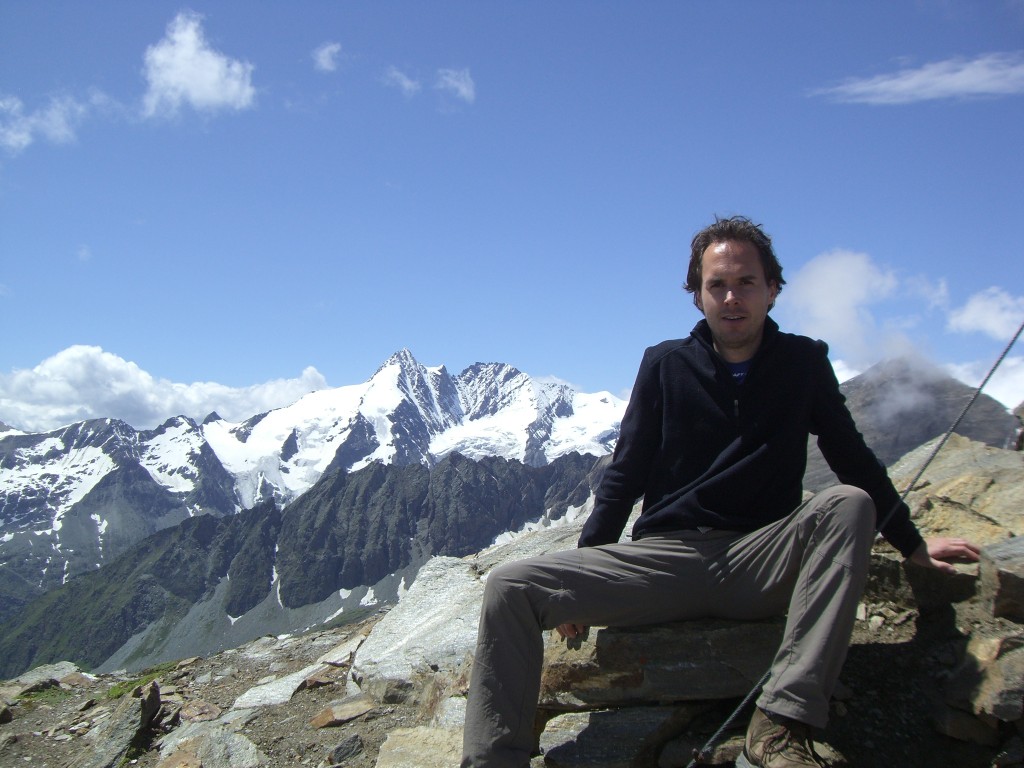
- On top of hoher Spielmann with Großglockner in the background
On Tuesday we had scheduled a glacier training on the Pasterze. The Pasterze is still the largest glacier in the eastern Alps. However, it is alarming to see how big it was before, and how little is left of it. On the glacier we learned to walk with crampons, to climb on ice and use the ice ax. Philipp hammered with such enthusiasm on the ice with his ice ax, that one could be surprised that there was still something left of the Pasterze in the evening.
On Wednesday we had the nest 3000 m top on our programme: Mittlerer Bärenkopf at 3358 m. Today we should be able to practice our glacier experience acquired the day before, because we moved mainly in a rope team on the glacier. In sunny, warm weather, I realized clearly that the combination of bad shoes and no gaiters was not optimal – I had ice water in my shoes all day. Shortly before the summit, we had to walk along a beautiful narrow ridge, which was kind of helpful as a habituation for the Glockner. At the summit we were rewarded again with a fantastic view.
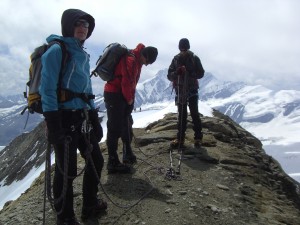
- Friederike, Helmut and Philipp in full gear at the top of Mittlerer Bärenkopf
On the way back we trained crevasse rescue in the rope team: A participant secured with a rope throws himself over a snow edge into the depth, and the others pull him up again. After a nice break on a sunny cottage, we went back into the valley. Or we almost skied in our hiking boots down the glacier in the rope team, which was a very fast way to get down (Helmut in the front was the pacemaker), but it was interrupted constantly by all of us falling into the snow, because at some point the persons behind could no longer keep up the speed so that the rope was pulling from both sides.
Thursday was our first possible summit day for the Großglockner. At 7 o’clock we headed off towards the Adlersruhe, the hut just below the Großglockner peak. Our plan was to arrive there early afternoon, only stop for a short refreshmentin, and in case of good weather start the 1.5 hours climb to the summit. As we ascended to the Stockerscharte, we had the sun in our backs, and it was very warm. Around 10 AM we reached the Salmhütte cottage where we enjoyed a little snack. Then we continued to climb up to the Hohenwartscharte. On fixed ropes, we scrambled up the rather steep wall.
Meanwhile, it became overclouded, and Helmut wanted to reach the Adlersruhe as quickly as possible. Before we had to cross a snow field in which we partially – under loud lamentation by Frank – sank waist-deep into the snow. The fact that we were approaching the Adlersruhe, we noticed first as we heard the rumble of the cable car for material. We couldn’t see it until we almost touched it with the nose – so dense the fog had become. After two hours of waiting – now there was a storm outside and it had started to rain – we decided to postpone the summit attempt until the next day. The night we slept in a 28-bed camp, which was actually only half full, but we still couldn’t sleep because of the triad of snoring, the rattling of the door and the raging storm outside.
At 5:30 clock on Friday morning we met for breakfast. Outside was the same white inferno of fog and storm like the day before. I had expected that we would begin the descent – without reaching the summit. But after a brief meeting, the guides decided to try the ascent after all. So we geared up with warm clothes (long underwear, hiking pants, rain pants, fleece pullover, jacket, scarf, hat, gloves, two pairs of socks), and equipped with crampons and ice axes we were on our way. Initially we walked through snow on a relatively flat ridge and then teamed up in a rope team on Glocknerleitl. There it was so steep, windy, and icy, that one had the feeling of being in the Himalayas rather than in the Alps. When we arrived at Kleinglockner, the “pre-summit”, Helmut let us down on a rope to the Glocknerscharte. Because of the poor visibility we could not (or did not have to) see how steep and deep it went down on both sides. In the order Friederike-Philipp- Stephan-Frank-Helmut, we crossed the difficult passage. After a final short climb, the summit cross suddenly emerged from the fog in front of us. We had made it – an awesome feeling!
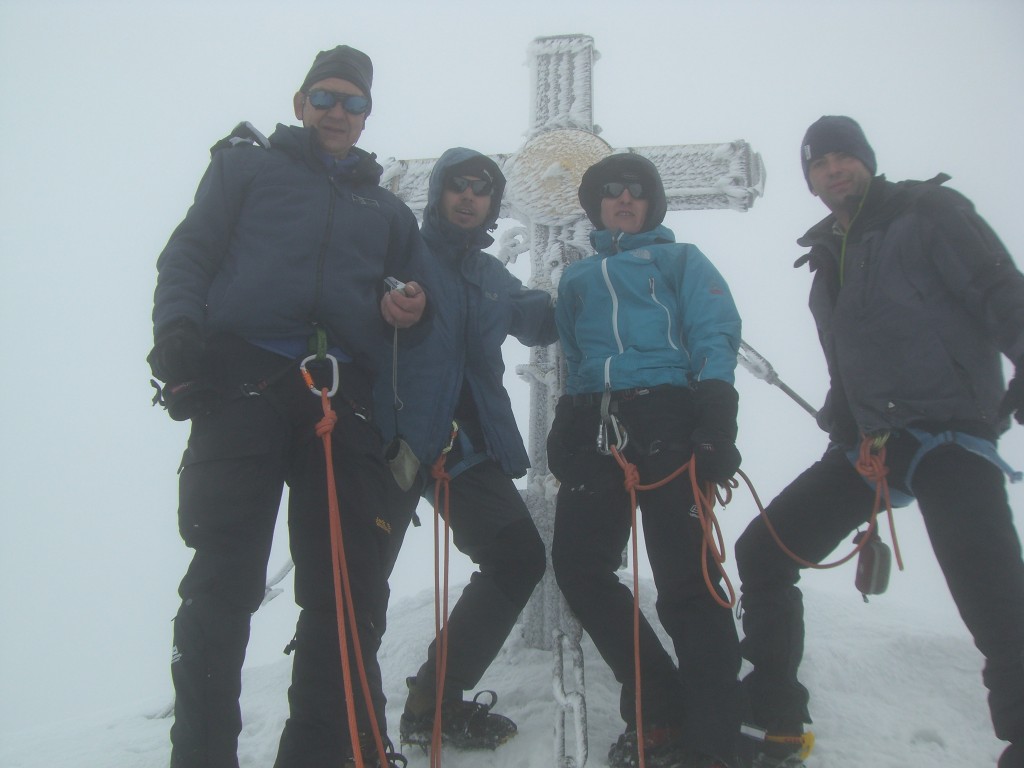
Frank, myself, Friederike and Philipp - proud and happy on the top of Austria
After a short photo session with Helmut as photographer, we went back to start the descent. Here we met a group of Russians, which we had to pass by on a narrow point on Glocknerleitl – something that led to great commotion and much shouting from the Russians. After a short refreshment with apple strudel on the Adlersruhe, we packed our backpacks, which were deposited there, and climbed down to Salmhütte where we enjoyed the first Radler of the day. From there we went back to Stockerscharte and down to Glocknerhaus, which because of the approaching thunderstorm should become a slightlz uncomfortable finish. But everything went well, and after a refreshing shower, we were able to celebrate with a delicious dinner and clink glasses several times for the fact that we had climbed the highest mountain in Austria.


